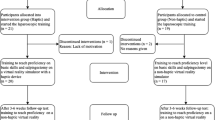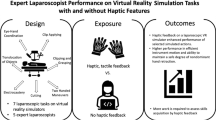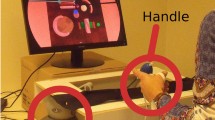Abstract
Background
Haptics is an expensive addition to virtual reality (VR) simulators, and the added value to training has not been proven. This study evaluated the benefit of haptics in VR laparoscopic surgery training for novices.
Methods
The Simbionix LapMentor II haptic VR simulator was used in the study. Randomly, 33 laparoscopic novice students were placed in one of three groups: control, haptics-trained, or nonhaptics-trained group. The control group performed nine basic laparoscopy tasks and four cholecystectomy procedural tasks one time with haptics engaged at the default setting. The haptics group was trained to proficiency in the basic tasks and then performed each of the procedural tasks one time with haptics engaged. The nonhaptics group used the same training protocol except that haptics was disengaged. The proficiency values used were previously published expert values. Each group was assessed in the performance of 10 laparoscopic cholecystectomies (alternating with and without haptics). Performance was measured via automatically collected simulator data.
Results
The three groups exhibited no differences in terms of sex, education level, hand dominance, video game experience, surgical experience, and nonsurgical simulator experience. The number of attempts required to reach proficiency did not differ between the haptics- and nonhaptics-training groups. The haptics and nonhaptics groups exhibited no difference in performance. Both training groups outperformed the control group in number of movements as well as path length of the left instrument. In addition, the nonhaptics group outperformed the control group in total time.
Conclusion
Haptics does not improve the efficiency or effectiveness of LapMentor II VR laparoscopic surgery training. The limited benefit and the significant cost of haptics suggest that haptics should not be included routinely in VR laparoscopic surgery training.


Similar content being viewed by others
References
Sutherland LM, Middleton PF, Anthony A, Hamdorf J, Cregan P, Scott D, Maddern GJ (2006) Surgical simulation: a systematic review. Ann Surg 243:291–300
Society of American Gastrointestinal and Endoscopic Surgeons FLS Trainer Box (2008). http://www.flsprogram.org/trainerbox.php. Retrieved 7 Feb 2010
The American Board of Surgery (2008) ABS to require ACLS, ATLS and FLS for general surgery certification. http://home.absurgery.org/default.jsp?news_newreqs. Retrieved 7 Feb 2010
Aggarwal R, Balasundaram I, Darzi A (2008) Training opportunities and the role of virtual reality simulation in acquisition of basic laparoscopic skills. J Surg Res 145:80–86
Panait L, Akkary E, Bell RL, Roberts KE, Dudrick SJ, Duffy AJ (2009) The role of haptic feedback in laparoscopic simulation training. J Surg Res 156:312–316
Salkini MW, Doarn CR, Kiehl N, Broderick TJ, Donovan JF, Gaitonde K (2010) The role of haptic feedback in laparoscopic training using the LapMentor II. J Endourol 24:99–102
Bholat OS, Haluck RS, Murray WB, Gorman PJ, Krummel TM (1999) Tactile feedback is present during minimally invasive surgery. J Am Coll Surg 189:349–355
Westebring-van der Putten EP, Goossens RH, Jakimowicz JJ, Dankelman J (2008) Haptics in minimally invasive surgery: a review. Minim Invasive Ther Allied Technol 17:3–16
Picod G, Jambon AC, Vinatier D, Dubois P (2005) What can the operator actually feel when performing a laparoscopy? Surg Endosc 19:95–100
van den Dobbelsteen JJ, Schooleman A, Dankelman J (2007) Friction dynamics of trocars. Surg Endosc 21:1338–1343
Schijven M, Jakimowicz J (2003) Virtual reality surgical laparoscopic simulators. Surg Endosc 17:1943–1950
Stefanidis D, Acker CE, Swiderski D, Heniford BT, Greene FL (2008) Challenges during the implementation of a laparoscopic skills curriculum in a busy general surgery residency program. J Surg Educ 65:4–7
Seymour NE, Gallagher AG, Roman SA, O’Brien MK, Bansal VK, Andersen DK, Satava RM (2002) Virtual reality training improves operating room performance: results of a randomized, double-blinded study. Ann Surg 236:458–463 discussion 463–464
Thompson J, Broderick T, Doarn C, Roesch M, Henry B, Stephan Z, Davis J, Weber J, Boyden M (2010) Refined task and proficiency criteria is required for optimal virtual reality minimally invasive surgery training. J Surg Res 158:250–251
Gallagher AG, Satava RM (2002) Virtual reality as a metric for the assessment of laparoscopic psychomotor skills: learning curves and reliability measures. Surg Endosc 16:1746–1752
Lucas SM, Zeltser IS, Bensalah K, Tuncel A, Jenkins A, Pearle MS, Cadeddu JA (2008) Training on a virtual reality laparoscopic simulator improves performance of an unfamiliar live laparoscopic procedure. J Urol 180:2588–2591 discussion 2591
Ayodeji ID, Schijven M, Jakimowicz J, Greve JW (2007) Face validation of the Simbionix LAP Mentor virtual reality training module and its applicability in the surgical curriculum. Surg Endosc 21:1641–1649
Acknowledgments
We sincerely thank the data collection team including Brian Henry, MD, Mr. Zack Stephan, Ms. Janna Davis, Ms. Maria Boyden, and Mr. John Weber for their determination. Salary support for Mr. Charles Doarn and Dr. Timothy Broderick and the purchase of the Simbionix Lap Mentor II VR simulator were provided by grant W81XWH-07-2-0035 from the United States Army Medical Research and Materiel Command and the Telemedicine and Advanced Technology Research Center.
Disclosures
Timothy J. Broderick has a consulting relationship with Ethicon Endo-Surgery. Jonathan R. Thompson, Anthony C. Leonard, Charles R. Doarn, and Matt J. Roesch have no conflicts of interest or financial ties to disclose.
Author information
Authors and Affiliations
Corresponding author
Rights and permissions
About this article
Cite this article
Thompson, J.R., Leonard, A.C., Doarn, C.R. et al. Limited value of haptics in virtual reality laparoscopic cholecystectomy training. Surg Endosc 25, 1107–1114 (2011). https://doi.org/10.1007/s00464-010-1325-2
Received:
Accepted:
Published:
Issue Date:
DOI: https://doi.org/10.1007/s00464-010-1325-2




